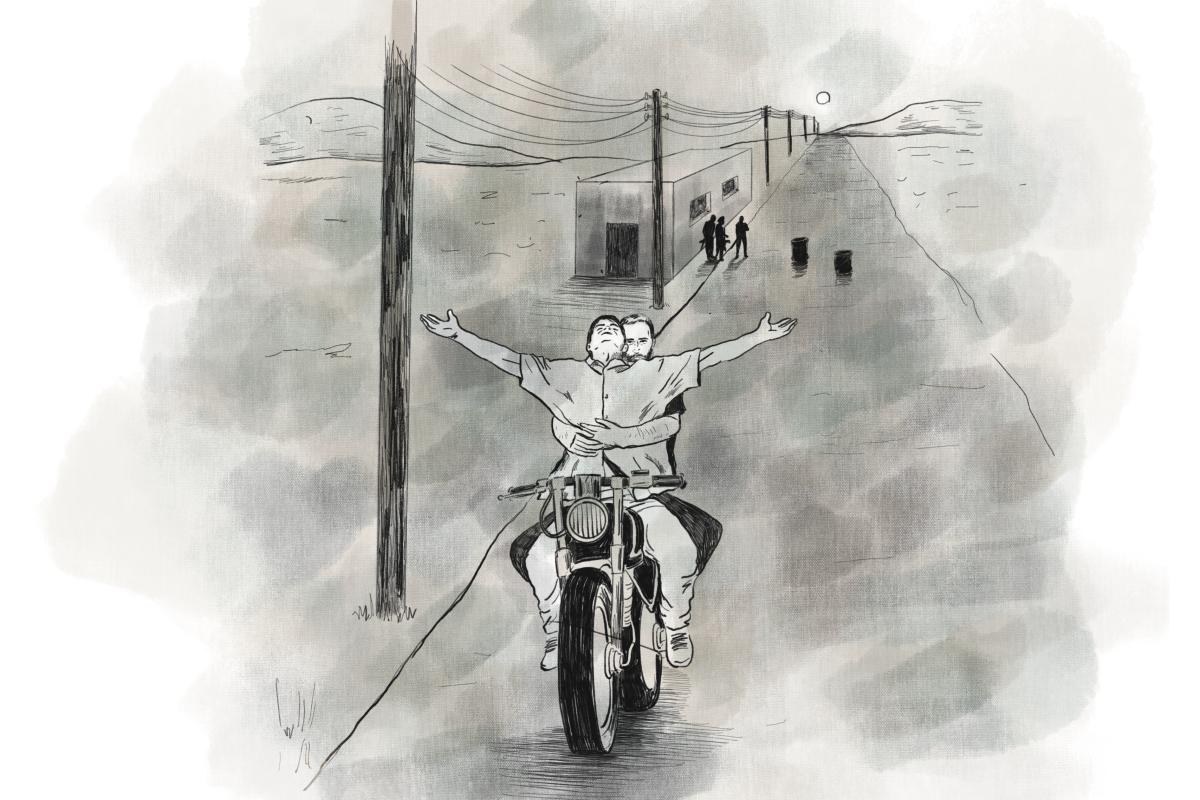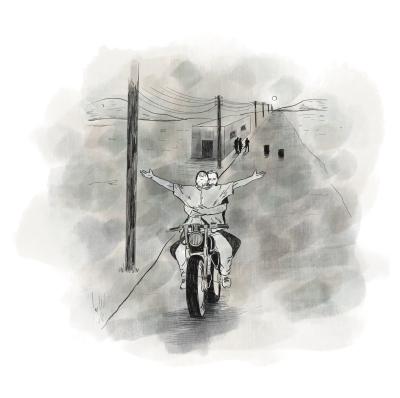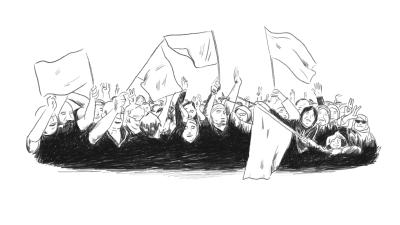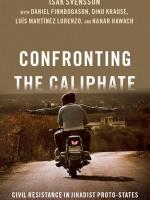
Confronting the caliphate
A few years ago, strange things started happening in the province of Idlib, Syria. The area had been under the control of the jihadist rebel group Hay’at Tahrir al- Sham for some time, but one day the rebels controlling the checkpoints scattered around the region were faced with a bizarre sight. Local men rode past the guards in pairs on motorbikes. In a community that heavily relied on motorbikes, and where people often gave each other a ride, there was nothing particularly strange about that. However, it was the way they did it: some were hugging each other tightly, some were seated sideways as if sitting together on a sofa, all the while waving at the guards. One day two men even rode by, one with his arms outstretched with the other hugging him from behind, in a pose unmistakably similar to the famous love scene from the film Titanic.
What might look like a comic spectacle at these particular checkpoints in this particular region was actually much more serious: it was a protest against the governing jihadists during one of the most brutal and intense armed conflicts in contemporary times, the Syrian Civil War. The episode was recounted by one of the two protagonists to a group of researchers exploring non-violent civil resistance in so-called jihadist “proto-states,” that is, territories controlled and governed by jihadist armed groups.
The big questions the researchers wanted to answer were how and when – even under the most repressive regimes – people were still able to find ways to protest, why some of these protests proved successful and what we can learn from them when trying to support civilians in jihadist conflicts around the world. Their findings have now been collected in the book "Confronting the Caliphate", co-authored by Isak Svensson, Daniel Finnbogason, Dino Krause, Luís Martínez Lorenzo, and Nanar Hawach.

The researchers had noticed that until now, scholarly debates around armed conflicts with jihadist rebel groups had been very much directed at the jihadist groups themselves and the governments in the contested areas ‘but very little of that knowledge had been transferred and applied to understand jihadist proto-states. At the same time very little data could be found about the civilians actually living in the proto-states established by the jihadists’, says Dino Krause, who is one of the authors, currently finishing his PhD on the global expansion of al-Qaeda and the Islamic State.
This focus has become even more relevant following the Taliban's rise to power in Afghanistan, where, according to Dino Krause, the conditions for civilians ‘are similar to some of the cases analysed in our book, especially with regard to the deprivation of civil and political rights, the strictly religious legislation and the brutal enforcement of it.’
In the book the researchers divide non-violent resistance into three categories:
Public protests: visible resistance, e.g. through demonstrations in the street.
Non-cooperation: the refusal to pay tax, participation in strikes, or the decision to stop sending children to school.
Everyday resistance: refusal to follow and fully live up to the expectations put forward by the jihadist authorities, e.g. when it comes to dress codes, forms of interactions between the sexes or restrictions on food and drinks.
In their book, the researchers have combined case studies of jihadist proto-states in Mali, Iraq, Algeria and Yemen, a survey with over 1,000 participants who lived under the Islamic State in Mosul, face-to-face interviews as well as data from local Arabic-language news websites about protests during the Syrian Civil War. And what they found is that not only do protests happen even under the most repressive and dangerous circumstances, they happen more often than we might think. For example, the researchers identified more than 600 village-level protests between the years 2014 to 2018 in areas controlled by jihadist groups during the Syrian Civil War. Moreover, the survey conducted in Mosul showed that more than 80 percent of the respondents reportedly engaged in at least one type of so-called everyday resistance during the rule of the Islamic State in Mosul from 2014 to 2017.

The initial spark
The premise of the book is that power ultimately relies on the consent of the people governed. This means that power is not understood as an inherent quality of the leaders but rather it is provided by a network of social structures. This is also the case for authoritarian and violent regimes – as well as the jihadist proto-state. ’To maintain their proto- state, the jihadists need people to pay taxes, abide by their laws and regulations, staff institutions (including hospitals, bureaucracies, schools, garbage collection, and so on)’, as the authors say in the book. And this in turn creates a space for people to withdraw their support in various ways.
Resistance often happens when people perceive the jihadists as brutal and alien to their customs.
In the book the researchers investigate precisely what makes people withdraw their consent. Why have people in some cases largely conformed to the jihadists’ rule, while others have protested violently? And why have people in other cases done neither but have rather resisted through non-violent means?
Here’s what the researchers found: first of all, people need to be angry about something.
‘Resistance often happens when people perceive the jihadists as brutal and alien to their customs’, says Krause. For this resistance to turn into visible protest, several factors need to be in play, he suggests: ‘there needs to be an opportunity, necessary resources, and finally strong civil society structures’.
When jihadist rebel groups took control over Kidal, Gao and Timbuktu in northern Mali in 2012, they introduced strict sharia-based law which caused people to flee by the hundreds of thousands. The strict regulations under which people were forced to live as well as the destruction of sacred shrines caused an uproar among the local population, who were used to a more moderate form of Islam. As a response, civil resistance rose all over the occupied towns, as well as the country’s capital, Bamako. Local imams and other prominent individuals refused to cooperate with the extremists, people blocked the entrance to a town square where the jihadist police were to amputate the hands of alleged thieves, and parents took their children out of school in Timbuktu after boys and girls were put in separate classes and girls were forced to wear full-body robes.
In the book, the researchers find that the clash between the local culture and the jihadists’ interpretation of Islam that they tried to enforce on the population was a strong motivating force behind the protests that occurred. These protests were made possible because Mali had a tradition for open political debate as well as strong civil society organisations, including various influential women’s associations, with networks and resources for non-violent mobilisation.

...even under the most repressive rule almost everyone still found a way to resist.
When the Islamic State of Iraq – a much smaller predecessor to the 2014 self-declared caliphate – was established in parts of Iraq’s so-called ‘Sunni triangle’ in 2006, the jihadists’ strict and brutal rule sparked a different kind of reaction compared to the Malian case. In this region, the dominance of tribal networks with different gender norms, customs for dispute resolution, easy access to weapons, and readily mobilised militias led to violent resistance against the jihadists. However, when the Islamic State later seized control of Mosul in 2014, the civilian population found other ways to resist, which were more individualised and covert. Krause explains:
‘Islamic State’s occupation of Mosul, Iraq was one of the most repressive of all the cases we studied. Here people were more hesitant to go to the street but they found other ways to resist, for example by taking their children out of IS-run schools, refusing to pay taxes, quitting their job, listening to music even though it was forbidden, shaving their beard (in the case of men), or leaving the house without a male companion (in the case of women). So even under the most repressive rule almost everyone still found a way to resist.’
The same goes for the motorcyclists in Idlib, Syria. Here the jihadist group controlling the area had decided that two men sitting together on a motorbike was immoral if the passenger’s arms were either holding the driver’s shoulders or hugging the driver as he sped up. Consequently, they introduced a rule that the passenger on the back of the motorbike should sit sideways. This was seen as not only impractical but downright laughable by the local population and instead of abiding, people chose to show their frustration in a humorous manner and finally the rule was retracted.

Does it work?
‘When studying non-violent resistance in the context of war, it can be very difficult to separate the effects of these actions from the effects of the actions on the battlefield. It is even more difficult to measure the effects of individual acts of resistance, like keeping your child home from school, smoking or refusing to pay tax. Yet, even these seemingly minor acts of defiance matter, not least because people tend to be influenced by the behaviour of people in their social network’, says Krause.
...even these seemingly minor acts of defiance matter, not least because people tend to be influenced by the behaviour of people in their social network.
As regards the effects of larger, collective demonstrations, the researchers found that the more specific demands protesters would put forward, the more likely it was that the jihadists would make concessions. For instance, lifting a road blockage bears a much lower cost for the jihadists than giving in to peoples’ demands to abandon an entire village or town. However, according to Krause, the researchers noticed that this was only true to a certain extent:
‘We talked to people in Idlib, Syria, who over several months kept formulating one major demand. They wanted the jihadists from Hay’at Tahrir al- Sham to abandon their town, which the jihadists refused for a long time. But the protests just went on and on and, in the end, they were successful in ousting them from the town. So basically, what we found was that the larger demands take more time until they can be fulfilled whereas the more specific demands may sometimes be met immediately.’
Another factor which had an impact on success was whether protests were isolated or supported by other protests. In what the researchers refer to as the “Olive Oil Campaign,” residents of the small town of Kafr Takharim in Syria took to the streets after Hay’at Tahrir al- Sham wanted to impose a tax on the olive oil harvest. The protests were initially repressed but then protests started popping up across several neighbouring towns controlled by the same jihadist group, where people were holding up signs in support of Kafr Takharim. After the pressure on the rebel group started to grow the jihadists finally had to give in.
‘What this case illustrates is that one protest happening once may not be sufficient to make a difference but if the jihadists have already seen seven or eight protests during the past month, they may feel a greater pressure to make concessions, says Dino Krause.
The role of civilians in conflict
By turning attention towards non-violent civilian resistance, researchers by no means wish to underplay the significance of military confrontations in determining the outcome of war and conflict. In almost all cases there is a multitude of factors that interact, says Krause.
‘When the people of Algeria for example managed to fight off the jihadist group GIA in the 1990’s, civil resistance played an important part, but so did the fact that the jihadists suffered military losses in the fight against the government. However, civil resistance is an underexplored avenue of how civilians in these proto-states can act to counter the jihadist governance project and I think we should pay more attention to that’, says Krause.
...civil resistance is an underexplored avenue of how civilians in these proto-states can act to counter the jihadist governance project and I think we should pay more attention to that
One important finding in the book is that what makes collective civil resistance possible is a strong civil society and this is important knowledge when international leaders, NGOs and policy makers attempt to deal with jihadist conflicts around the world, says Krause:
‘Civil society matters, local NGO’s and women’s organisations play a big part as well as the ability of civil populations to mobilise resources and then use those resources to resist. Governments and the international community can work to strengthen these structures by building strong civil societies, financing local NGOs and supporting women’s organisations on the local level’.
In line with this, the people who protest, though very diverse both in gender and age, share one common denominator: they are connected.
‘What we see is that people are usually socially well-connected, they use the internet regularly, and they often coordinate their resistance with each other. They are also influenced by what happens around them. This makes the communication infrastructure and freedom of press another key point: Making sure that people have access to the internet and supporting a free press being able to cover these protests, even from afar, in order to help these resistance campaigns to spread.’
“Confronting the Caliphate” by authors Isak Svensson, Daniel Finnbogason, Dino Krause, Luís Martínez Lorenzo, and Nanar Hawach is published by Oxford University Press.


